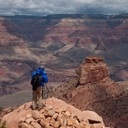15 Likes
A school of anchovies swarms together, forming a scintillating mass attacked from above and below in a fascinating example of interspecies hunting. This happens every day in New Caledonia's vast coral reef lagoon.
Predatory fish must identify a particular fish to catch it. The anchovies create a speeding vortex of thousands of individual fish moving in perfect unison so the predators can't single one out. But these huge jacks knew exactly what to do. They coordinated their attacks, some of them coming up from below while others peeled the anchovies away from the ball, right into the path of the ascending fish that would burst right out of the water with a fountain of glittering anchovies all around them. In the mayhem the anchovies would scatter, making perfect targets for the predatory fish and for the birds.
Red billed sea gulls (Larus novaehollandie) understand the strategy. They flew right above the jacks that were striking in from the side so the birds were in exactly the right spot to feast on the fountain of anchovies when the big jacks came bursting up from the depths. The gulls sometimes snatched anchovies right out of the mouths of the striking fish - then leaped back into the air, often tossing their catch into the air and then gulping it down.
After about 20 minutes of this mayhem it got really wild. Other species of fish joined in, barracuda, mackerel, snappers. A school of sharks swam around the whole group, moving in closer and closer, maybe picking up titbits of hashed sardines. More birds came from every direction, flocks of Noddy turns (Anous tenuirostris), stayed maybe 20 to 50 metres away from the centre of the feeding frenzy. A few of the tiny, white " Black Naped Turns", (Sterna sumatranta), circled around but they, like the noddy turns, stayed away from the centre of the intensive feeding frenzy. Possibly because the sea gulls might get aggressive if the smaller turns got in their way and would certainly try to steal any fish the smaller birds caught. You can see in the sphere image that when one sea gull caught a fish and didn't get the fish down the gullet fast enough, the other sea gulls made serious tries at stealing it.
This is fishing in the extreme, with continuous action that goes on for up to three hours with a bewildering array of species harvesting the small but abundant schools of "bait" fish.
...





New Caledonia is the closest South Pacific Island to Australia and New Zealand. It is a French Territory and although the official language is French the culture is a blend of Melanesian, European, Polynesian, Vietnamese, Chinese, Indonesian, and more. There is one large mountainous island called Grande Terre and 6 smaller islands - the three Loyalty Islands, Belep and the Isle of Pines.The islands are remarkably unpopulated and there are vast areas of wilderness. There are hundreds of kilometers of walking treks, camp grounds, more than 42 parks and reserves, and crystal clear rivers with sparkling waterfalls. Almost one third of the population is located in the capital city of Noumea. Nickel mining is the primary industry and is the major contributor to the high standard of living in the country. Grande Terre is surrounded by the second largest barrier reef in the world and the protected lagoon created by this barrier reef is the largest in the world. Listed as a World Heritage Site in 2008, the lagoon is 24,000 square kilometers and supports a diverse and luxuriant fauna of fish and invertebrates.The vibrant, clear and rich colors are one of the first things that visitors notice when they arrive. Noumea has a complete range of hotels, resorts, restaurants, and activities to welcome visitors.